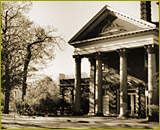
Origins
The Faculty of Law at U of T is built on a strong historical foundation of leadership, innovation, and a bold willingness to take risks. Established in 1887, it is one of the oldest professional Faculties at the University of Toronto. However, it wasn’t until 1949 that the blueprint for the modern law school was drafted.
The Foundation of the Modern Law School
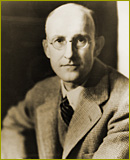
| In the 1940s, the only way of becoming a lawyer in Ontario was through the Law Society of Upper Canada, the governing body of the legal profession in the province, which operated a school at Osgoode Hall. There, the law program consisted of three (and later four) years of on-the-job training complemented by a few law courses. In contrast, the law program at U of T offered a four-year Honours Bachelor of Arts in Law degree created under the leadership of Dean W.P.M. Kennedy, a staunch supporter of rigorous academic education for lawyers. Read Prof. Martin Friedland's discussion of 'The Enigmatic W.P.M. Kennedy'. Dean Kennedy developed a strong academic law program at U of T's Faculty of Law |
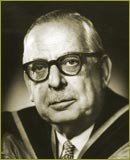
| In 1949, when Kennedy retired, the legendary Cecil (“Caesar”) Wright assumed the deanship of U of T's law school. He first had to resign his post as Dean of Osgoode Hall, rejecting the Law Society's apprenticeship model in favour of U of T's vision of a full-time legal education, hinging on the professional bachelor of laws degree and centred in a university. As the new dean of U of T's law school, Wright built upon the solid intellectual and institutional foundations laid by Kennedy, creating a new kind of law school that would transform legal education in Canada. Dean Wright built the modern law school on strong foundations |
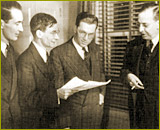
| Joined by colleagues Bora Laskin and John Willis, Wright immediately revamped U of T’s law programs, establishing an intellectually challenging program for his students. Read more about Bora Laskin and his role. From left to right: Professors John Willis, Bora Laskin and Cecil "Caesar" Wright |
Despite the law school's solid academic program, the Law Society of Upper Canada refused to recognize U of T as a degree-granting institution. In the early 1950s, law students and their supporters petitioned the Law Society, and in 1953, a group of 50 student protesters marched on Osgoode Hall demanding recognition for U of T Law School. Finally, in 1958, after years of negotiation and discord, the Law Society began to give credit to U of T law graduates seeking admission to the Ontario bar. At this historic moment, Dean Wright was moved to tears, finally having won the long battle. 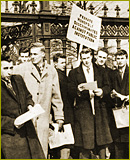 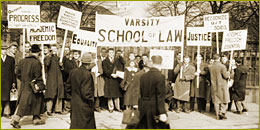
Dean Wright and his predecessor, Kennedy, charted the course of the law school, establishing its core values and traditions of scholarly excellence, societal relevance, institutional leadership and risk-taking. Over the years, the Faculty has continued to be led by deans of exceptional vision and commitment who have upheld these guiding principles, and who together have created one of the leading law schools in the world. |
Deans of the Faculty of Law
- W.P.M. Kennedy (1943-1949)
- Cecil Wright (1949-1965)
- Ronald St. John Macdonald (1965-1972)
- Martin Friedland '58 (1972-1979)
- Frank Iacobucci (1979-1983)
- J. Robert S. Prichard '75 (1984-1990)
- Robert Sharpe '70 (1990-1995)
- Ronald J. Daniels '86 (1995-2005)
- Mayo Moran '99 (SJD) (2006-2014)
- Edward Iacobucci '96 (2015-2020)
- Jutta Brunnée (2021- )
50th Anniversary Video
In 2002, on the occasion of the 50th anniversary of the first graduating class of the modern law school (1952), the Faculty commissioned a video exploring the law school's first 50 years through interviews with alumni and teachers.
Class of 1951
While the class of 1952 is generally regarded as the first class to graduate from the modern Faculty of Law, the members of the small graduating class of 1951 have a remarkable story. Read their story.
The Law School Buildings
The law school has moved its location several times since its foundation, but for many year now it has been housed in two historic buildings on the St. George Campus of the University of Toronto: Flavelle House and Falconer Hall.






